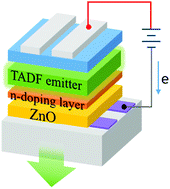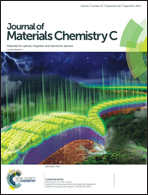n-Doping-induced efficient electron-injection for high efficiency inverted organic light-emitting diodes based on thermally activated delayed fluorescence emitter†
Abstract
High-performance inverted organic light-emitting diodes (OLEDs) based on thermally activated delayed fluorescence (TADF) emitters are achieved using solution-processing n-doped 4,7-diphenyl-1,10-phenanthroline (BPhen) film with cesium carbonate (Cs2CO3) as the buffer layer between ZnO and BPhen layer. The n-doped BPhen interlayer shows better electron-transporting properties than undoped BPhen film and reduces the electron-injection barrier from ZnO to BPhen layer. The inverted OLEDs, based on TXO-PhCz emitter incorporating the solution-processed Cs2CO3-doped BPhen film as an interlayer, show a maximum external quantum efficiency of 16.4%, current efficiency of 53.9 cd A−1, and power efficiency of 35.6 lm W−1, which realize unprecedentedly high-efficiency TADF-based inverted OLEDs. These results are competitive with the properties of inverted OLEDs based on phosphorescent emitters, implying that TADF emitters have potential to substitute for phosphors on realizing air-stable and large-area displays.



 Please wait while we load your content...
Please wait while we load your content...